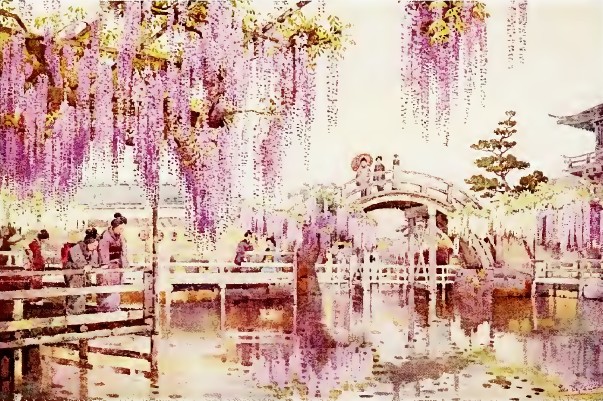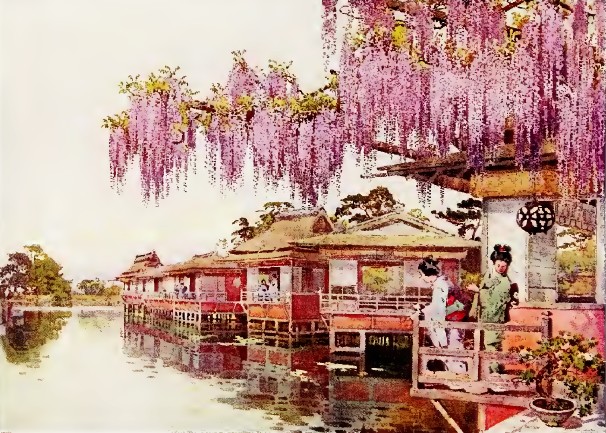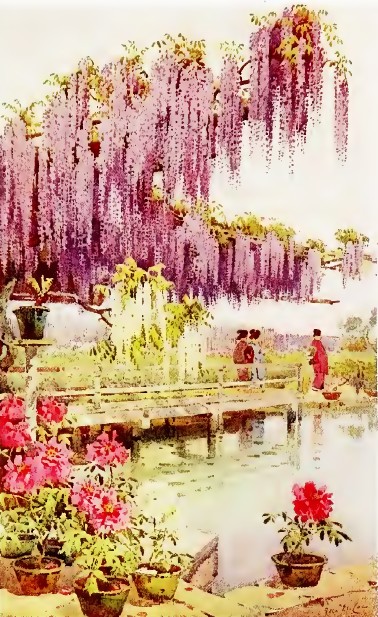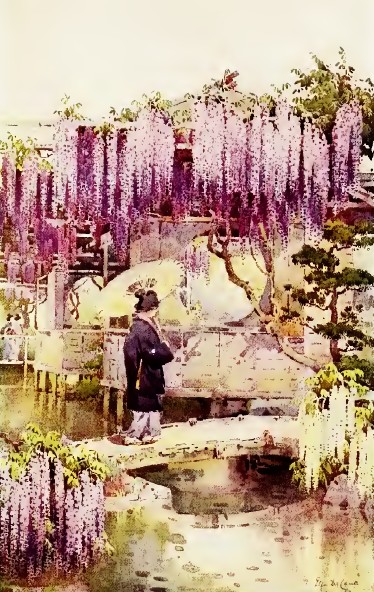| Web
and Book design,
Copyright, Kellscraft Studio 1999-2013 (Return to Web Text-ures) |
 (HOME)
|
| CHAPTER
X WISTARIA AND PĆONY THE last petals of the cherry blossoms have only just fallen, and Nature hastens to provide a new treasure for the flower kingdom, and the first blooms of the wistaria Fuji no hana will be opening at the base of the quickly growing racemes. Not the far-famed Wistaria multijuga, whose immense long sprays of delicate mauve flowers are so associated throughout the world with the name of Japan, but the early-flowering wistaria, Brachy botris, with its tufts of white blossoms completely covering the closely pruned branches before any trace of a leaf appears. It would seem as if this modest white wistaria had been allowed by nature to bloom so early, for fear she should be overlooked and not appreciated when her more showy successor flings her purple mantle over the land. The Royal Fuji, fancifully called Niki-so, meaning "plant of the two seasons," because, appearing between the third and fourth months (old calendar), it belongs both to spring and summer, has rightly attained her high rank among the floral kingdom of Japan, for in no other country can be seen a restaurant set out for the entertainment of perhaps a hundred guests, who will all feast wrapped in the purple haze of a roof of wistaria blossoms, all from a single vine. Perhaps the most popular haunt of the pleasure-seeker in the month of May is the celebrated Kameido Temple in Tokyo. Words fail me to describe the beauty of the scene: it is a real feast of fuji; the long purple trails cover the large trellises, the wide rustic galleries, and connect the little matted restaurants, where hosts of people throughout the day sit feasting under the purple roof and feeding the gold fish in the lake. The matted benches are set out on a thick mauve carpet of fallen blossoms, and the little maids seem to have a never-ending task in sweeping away great heaps of the freshly fallen flowers, as though fearing that their guests will be smothered by them. No one seems to know so wisely as the Japanese in what surroundings to plant their flowers, so as to show them to their best advantage. Wistaria seems always to be grown near water, so that the trellis which is to bear its flower burden can be built out over the water. So it is at Kameido; and as I sat surrounded, almost smothered, by the blossoms, inhaling their delicious scent and listening to the droning of the bees, I could gaze across the water at the reflection of a never-ending vista of mauve blossoms reaching on one side to the celebrated round wooden bridge, the delight of children, who seemed to cross it in one ceaseless stream, and on the other to the fine old temple, where a few ancient pine-trees are placed just where they will best harmonise with the long purple blossoms. The late sweet-scented white variety will prolong the fuji season by a few days; their glory is but short-lived, a few days and then their colour begins to fade, the leaves appear among the blossoms, and their beauty is gone. I felt if I wanted to see wistaria again that year I must fly to the northern provinces, where the bean-scented blossoms will soon be clothing the forest trees. I turned away sadly, not forgetting the Japanese theory that the wistaria loves sake go strong is their belief, that I was told that if you set a jar of the wine under the plant, its spray will grow longer from its desire to reach the jar; so I ordered my little cup of saké, sipped it, and then emptied the cup on the roots, according to their custom, hoping that I too might help to. contribute to its great size and beauty.
 Wistaria, Kameido Very lovely is the scene at Kashukabe, where another famous wistaria grows. The vine is said to be some five hundred years old, its pendent clusters over 50 inches long and growing over trellises covering a space of 4000 feet. Noda in the province of Settsu is also celebrated for its wistaria, and a special variety has been named after the place. The cultivation of Wistaria multijuga, with its racemes from two to three feet in length, and the individual flowers having a lip of darker purple, seems to belong more especially to the eastern provinces. And it must not be imagined that all wistaria in Japan has these immense long sprays. In the whole neighbourhood of Kyoto I know of only two fine specimens of multijuga and all the wild variety seems to be Wistaria chinensis, with its tufts of shorter racemes. Towards the end of the first week in May I made a pilgrimage to see the wistaria blossoms in Kasuga Park at Nara, and I shall never forget the enjoyment of that day, the blessed relief of being able to find a quiet spot away from the gazing crowd, in which to ramble or sit and enjoy the scene. The vines have clambered to the top of many of the tallest pines and cryptomerias, and their blossoms hang in wreaths; in the distance the effect was suggestive of smoke rising among the trees. Many of the lower trees seemed to have been completely taken possession of by the trespasser, and the dead branches transformed into big bouquets of pale mauve. How far more beautiful were these natural supports than the somewhat unsightly bamboo poles which usually form the trellis for the vines. Little glades, down which winds a tiny clear stream, divide the ground, and the banks were covered with these old trees, completely smothered by the weight of blossom. Often the vine seemed not content with covering a single tree, but had thrown out long branches beyond, which, fallen to the ground, had rooted and then risen again to find a fresh prey, thus forming a double arch wreathed with purple tassels. This park is one of the few places in Japan where there is real turf, closely cropped by the herd of deer, and in the open spaces broad stretches of brilliant-coloured Azalea sinensis added to the enchantment of the scene and formed a perfect foreground. To the Japanese mind the fuji is essentially feminine, and they find in the wistaria their ideal of woman, — the Japanese woman — whose charm of temperament and whose beauty has been so praised. It is a pretty idea, and it is not difficult to understand their ideal of woman when one observes how the wistaria clings to the undaunted pine, and how gently she falls down, easily moved by a breath of wind and yet firmly holding her own place. The wistaria is regarded as the emblem of gentleness and obedience, and these are the keynotes of a Japanese woman's character. The young tender leaves of wistaria are sometimes eaten, and also used in the place of tea; and the flowers themselves are used for food in some parts of China. The seeds baked in the fire have very much the same flavour as that of a chestnut. The bark is used for ropes and sandals; and its branches are used, it is said, as cables, and also for bridge-making, as it is supposed that there is nothing more durable than a wistaria bridge. Japanese antiquarians will tell you that in olden times, before carpenters' tools had been invented, the dwellings of the people in Japan were constructed of young trees with the bark left on, fastened together with ropes made of the tough shoots of wistaria, and thatched with the grass called kava. Fuji appears to be a real Japanese flower, though in the Western countries it is called wistaria, in honour of Caspar Wistar, an American physician. One of the most celebrated classical No dances of Japan has wistaria as its theme. The little square boxes in front of the stage, with its long gallery or bridge (along which the No actors make their entrances and exits), are filled by the audience, apparently patiently waiting in quiet, somewhat sleepy expectancy. The long piercing sound of flutes mingled with the curiously sad rhythm of Tsuzumi drums has ceased; and the high distinct declamation of the libretto begins. The priest, who is a necessary part of any No dance, is the first to appear on the stage; he is supposed to reach Taka no Ura in the province of Ecchu, a place famous for wistaria, and here he meets a country girl who in a short time will reappear as the spirit of the wistaria; she entreats him to pray for her, so that through the virtue of his prayer her flower spirit may enter into Nirvana or Paradise; doubtless the spirit of the last flower of spring is not able to release herself from the world to attain Buddhistic perfection, so she hates to say her quick farewell to spring, Presently the flower spirit, arrayed in gorgeous purple brocade, dances her last spring dance, and then, after receiving the priest's repeated prayer, she will disappear with joy. So ends the No play, so full of emblematical meaning to the minds of the Japanese.
 Wistaria, Nagaoka The wistaria and pćony seem to be closely associated, as not only do they flower at the same time and many gardens seem devoted to their combined culture, but just as in Japanese literature the wistaria is an emblem of womanhood, so in Chinese literature the peony is compared to a beautiful woman. The peony seems to be a plant of Chinese origin, and though it can hardly be classed as one of the most popular flowers of Japan, it plays an important part in the art of the country. The tree peony is a delicate plant and requires scrupulous care and nursing in order that its blooms should attain their full size and colour. It is regarded as essentially the rich man's flower, and therefore it is often called the "flower of prosperity"; another fancy name by which it is known is the "plant of twenty days," because it will preserve its freshness and beauty for that time. The celebrated garden at Honjo in Tokyo combines the cultivation of botan (tree peony) with that of wistaria. A fine old vine of multijuga overhangs the pond; but one of the especial features of the garden is the cultivation of wistarias in pots and tubs — some grand old plants, flowering as though they would flower themselves to death. Others there were of all sizes and shapes; some bent and leaning, some bearing veritable canopies of blossoms; some pure white, some the pale mauve sinensis, and others the deeper-coloured multijuga.
 A Pćony Garden My first visit to "view the peonies" was rather a disappointment to me, as, in order to protect the blooms from heavy rain or wind storms, the plants are all placed under the cover of temporary matting sheds. They seemed mostly to be grown in pots, and the effect of these rows of plants, each with its large and heavy blossoms supported by bamboo stakes, was somewhat stiff and prim. A few stray plants there were, which, possibly for some slight defect in the shape or colour of the blooms, had not been included in the show collection; and to the uninitiated these gave most pleasure, left standing in the open, their colour blending harmoniously with that of the wistaria blossoms. The peony gardens seemed no haunt for the holidaymaker, but rather for the serious-minded gardener, who, truly interested in their culture, would spend hours in quiet contemplation of the plants, discussing the merits of the different varieties with some fellow-enthusiast. There were some hundred different kinds of the tree peony. The most prized ones were all either pure white blossoms, or those whose colour ranged from pale pink to red, — quite rightly, however rare they may be, the purple-hued and yellow are less valued. Many a private garden belonging to the rich has its peony show, and the plants are mostly brought from the neighbourhood of Nara, which is celebrated for its peony gardens. And the gardens at Kabata are also famous for their blooms; where too may be seen the combination of the fuji flowers covering long trellises and the little standard trees growing along the margin of the stream, their pendent trails reflected in the water, softening as it were the gorgeous splendour of the flaunting peony blossoms. There is no more gorgeous floral sight than the peony with its tremendous curling petals; but a Japanese artist told me that its fulness in splendour made those with a better poetical fancy and more quiet taste dislike it and think the beauty of the peony to be even vulgar. Japan is nothing if she be not light and airy, and therefore the Japanese consider flowers with more delicate grace to be more artistic; so the peony has little chance to become their favourite flower, its beauty is too heavy. It has found, however, some admirers among the poets of Western Japan. In comparison to the people of the eastern provinces the inhabitants of Osaka and Kyoto are said to be more showy in their taste, their art is heavier, so the peony is called the Western Flower of Japan. If you compare China and Japan, the former's taste in art is more decorative and heavier, and remember what a favourite the peony is as a decoration for their priceless porcelain. The variety of peony known as Pćonia sinensis, the true Chinese peony, does not seem to be much regarded in Japan, and little attention seems to be given to its cultivation. The botan calls to mind the peony lantern, and the peony lantern or botan toro is suggestive of the Buddhist festival of Bon (from July 13-16), when the great gates of Hades will open wide, and those dead souls who are still wandering about, being unable to enter Nirvana, will come back again to receive their relatives' prayers, by whose virtue they may get their final rest. So this festival is universally called the Soul Festival: in literature it is closely connected with ghosts. The theatres will all play "ghost plays," as, of course, the story of the peony lantern is a ghost story. A beautiful girl called O Tsuyu was the daughter of a certain samurai Ijima San, who lived apart from her father with her faithful maid O Yone. She happened to love Shinzaburo Ogihara, a young samurai, and died of love, and her maid followed her. Ogihara did not know of their death. He observed one summer evening that two young women — who were O Tsuyu and O Yone — passed before the gate of his house, carrying peony lanterns in their hands, and he welcomed them. During the following seven nights O Tsuyu called on him at night with her usual peony lantern in hand; and then Shinzaburo was told by his friend that she was not a living person, but a ghost. He appealed to some holy priest to protect him from the ghost. The priest gave him some charm to hang at his door; and when the charm one night was taken away, Ogihara was found dead the next morning. There
is a rather charming ghost story of the peony which is of Chinese
origin; the story is called the Ko Gyoku or Incense Jewel. Kaseikyu
of Rozan, of fairy beauty, is famous for its peonies. In Kaseikyu
there lived a young scholar called Kosei. He was looking out of his
window one day, and to his amazement he observed a beautiful young
lady dressed in white who stood among the peonies; he saw her so
often that he fell in love with her, and wrote a love-song dedicated
to her fair soul. Then she appeared as in a dream to him one day and
said, "My name is Ko Gyoku; I was brought here from the city of
Heiko, and my life is not without sadness." They promised to
love each other, they continued to meet every day, till one day Ko
Gyoku told him sadly that she had to go away; and the next morning,
strange to say, Kosei observed that the peonies in the garden had
disappeared. Was she not the spirit of one of the peonies? He passed
day and night in sad dreams and with many tears, thinking over his
unhappy fate in love. To his surprise Ko Gyoku appeared after a long
time, and they held each other's hands, but the man found the lady's
hand cold. Ko Gyoku said, "Yesterday I was the living spirit of
the flower, but to-day I am merely the ghost. My body is cold, the
flower is dead." However, she was to his eyes as beautiful as
before. She continued, "If you will be kind enough to give a
cupful of water to the roots of the old peonies every day, you will
receive a reward in due course of time," and disappeared. Kosei
found the next morning that new sprouts were beginning to come out
from the old roots.  Wisteria, Kabata The peony was introduced into Japan from China in the eighth century, but failed to gain universal popularity, on account of the difficulty of cultivating it successfully; but the Rich Man's Flower came to be regarded as the king of flowers, and therefore the lion and the peacock, the kings of the animal world, are its companions in art. They are always painted together in the decoration of a temple or palace wall, and when lions dance on the Japanese stage they always have a gorgeous background of peonies. There may be more of myth than truth in the pretty story of Ichinenko, a kind of peony, whose flowers turned crimson when Yo Ki Hi (the beloved mistress of the Emperor Genso, famous in Chinese history in connection with the peony) accidentally touched the petals of the flower with her rouged finger-tips, when she appeared in the garden after finishing her morning toilette. So strong is the feeling among Japanese poets that the flower is lacking in any poetical grace, that the Hokku 1 poet Hyoroku remarks in his Essay on a Hundred Flowers, "The peony is like the mistress glorified in one's love, who acts as she pleases without any consideration for another's feeling. It has such an attitude, as if it spit out a rainbow into the blue sky." The poet Bushon, who has written more lines on the peony than any other poet, says —
Hirakanto suru Is about to bloom Botan hana. The peony flower.)
1 Hokku is a poem of seventeen syllables. |